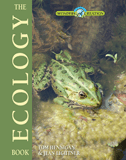
Everglades: An Ever-Changing Environment
The Everglades features one of the most diverse ecosystems on earth—with a surprising geological history.
There are no other Everglades in the world. They are, they have always been, one of the unique regions of the earth. . . . Their vast glittering openness, . . . the racing free saltness and sweetness of their massive winds, under the dazzling blue heights of space. They are unique also in the simplicity, the diversity, the related harmony of the forms of life they enclose.
–Marjory Stoneman Douglas, The Everglades: River of Grass
Turn onto Route 821 out of Miami, Florida, leaving behind the palm-lined streets and glinting skyscrapers, and drive about an hour west. When you step out of the car, you’ll find yourself in an entirely different ecosystem. Alligators float like logs in the foreboding swamps. Waterways and estuaries squiggle a path among the emerald landscape. Herons wade among the lily pads. Airboats glide over the shallow water. Welcome to the Everglades!
The Everglades sits like a jewel, unique in the United States’ collection of varied landscapes. Each year, a million people come to experience one of the most diverse ecosystems in the world. But few know that they are visiting more than just southern Florida. Deep under its surface, the Everglades is built on rock that was once part of Africa. This wet wonderland has gone through many iterations throughout earth’s history. In fact, the Everglades has been an ever-changing ecosystem since the biblical global flood cataclysm.
Land of Grassy Water
Before Spanish cartographers ever explored or even saw the land between the Gulf and Atlantic coast, they included the Everglades on their maps as Laguna del Espiritu Santo (“Lake of the Holy Spirit”). In 1773, after mapping the coast of Florida, British surveyor John Gerard de Brahm first used the term “Everglades.” But the Seminole, some of the original people who lived in the Everglades, call it Pahokee, meaning “Grassy Waters”—perhaps the best description of all.
Far from a mere swamp, the 1.5-million-acre Everglades is a natural subtropical wetland—the largest remaining in the US. Beginning near Orlando with the Kissimmee River, that water system empties into Lake Okeechobee—the big blue dot you see on an aerial map of Florida. Water leaving Okeechobee forms a slow-moving river spanning 60 miles (97 km) wide and over 100 miles (160 km) long, flowing south across a flat limestone shelf which creates the watery wilderness. All this water eventually empties into Florida Bay at the southern end of the state.
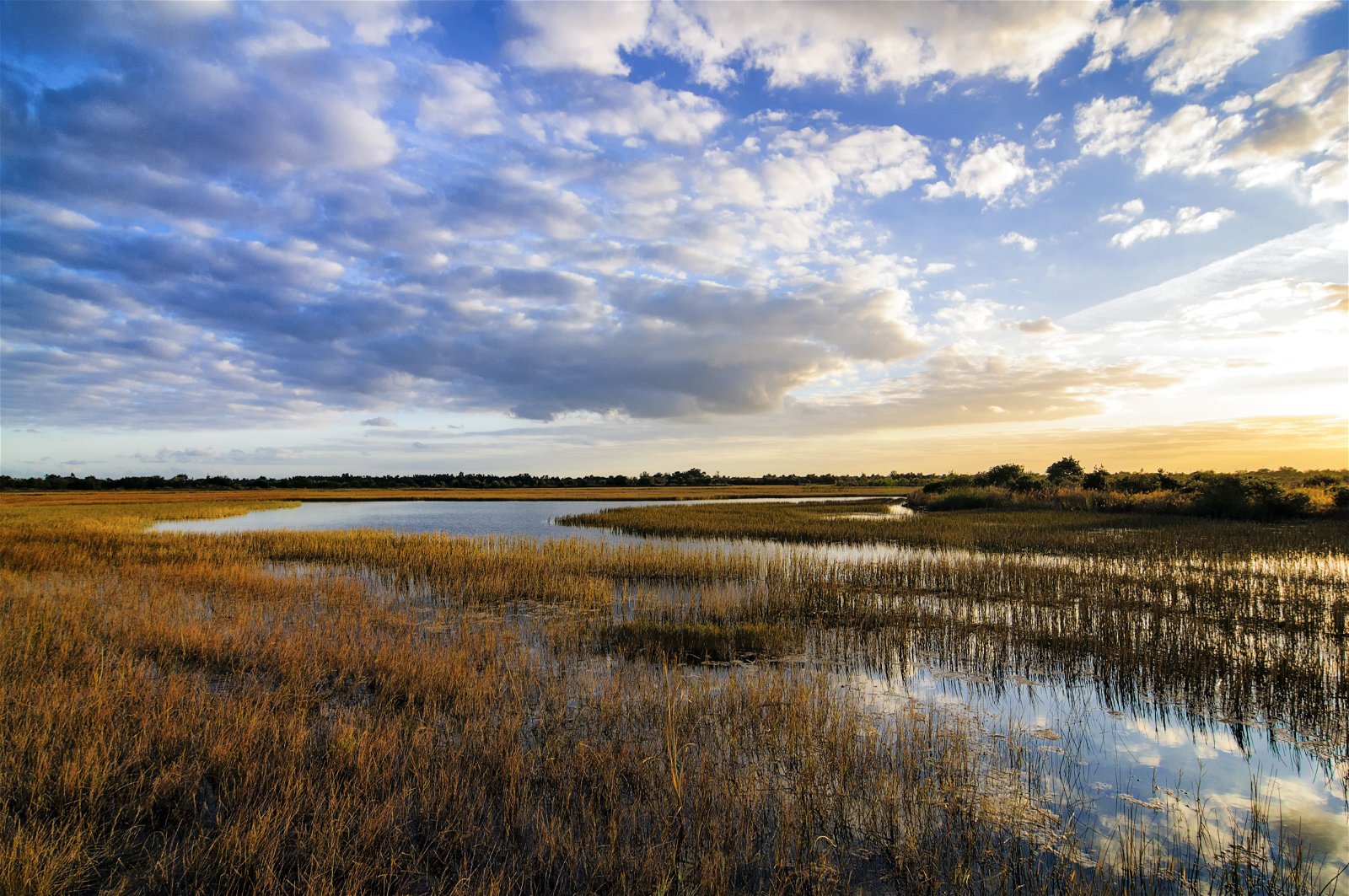
Sawgrass Marshes
Sub-Biome
Sawgrass marshes are the swampy areas most associated with the Everglades. Sawgrass grows well in slow-flowing water. Submerged and floating plants grow there, such as bladderworts and waterlilies. Alligators nest in the dense grass growth, and where water channels flow between these grassy prairies, other animals such as snakes, turtles, and fish thrive.
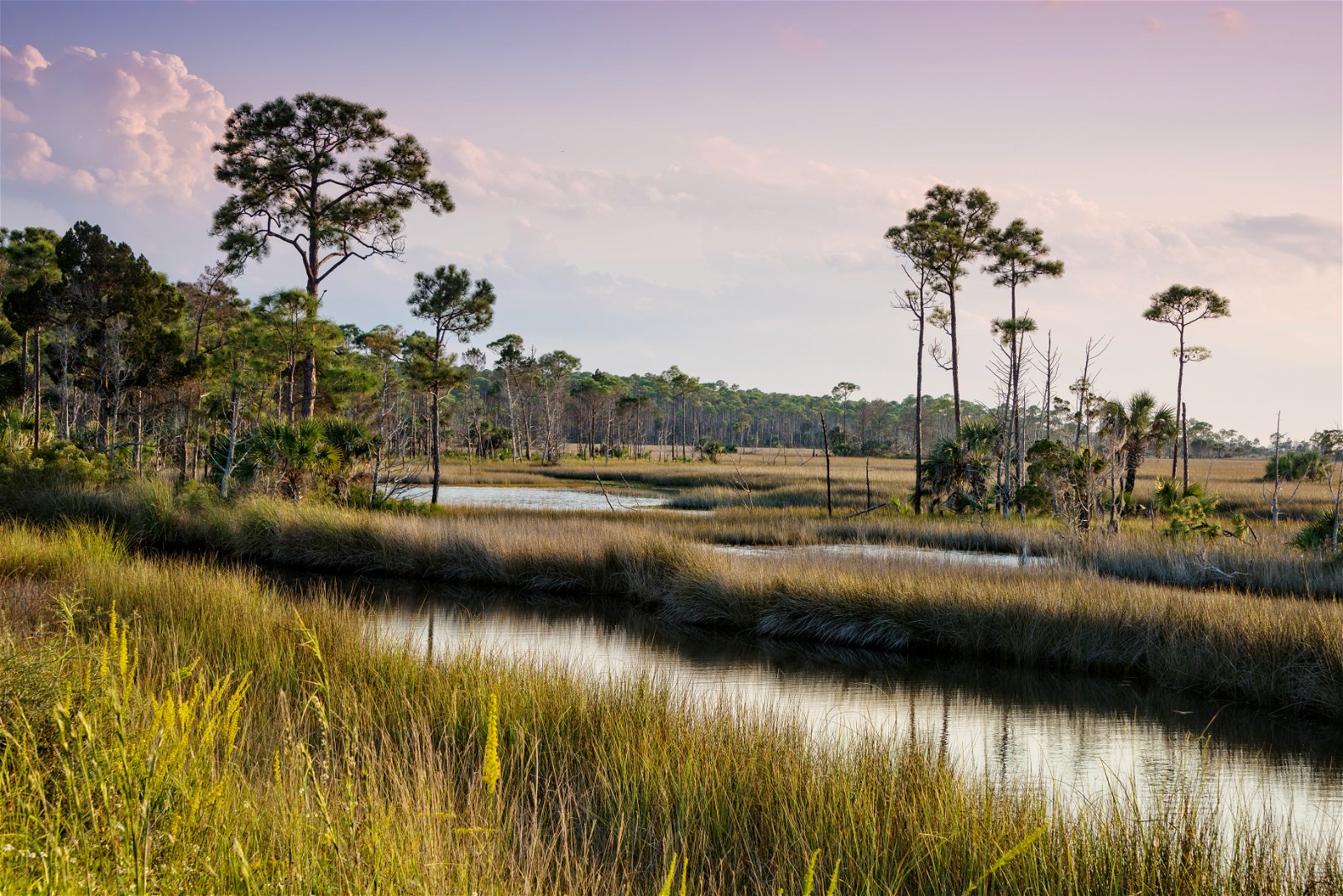
Pineland
Sub-Biome
In the most elevated part of the Everglades, the pinelands grow in the driest portion, which experiences little flooding. These pinelands are mostly made up of South Florida slash pine. These pine trees rely on fire to thrive. The flames burn away excess undergrowth on the forest floor, and the heat opens the pine cones to spread seeds. It’s a good thing because their dry needles are the perfect kindling for flames. God designed these trees with a fire-resistant bark that protects them from the heat.
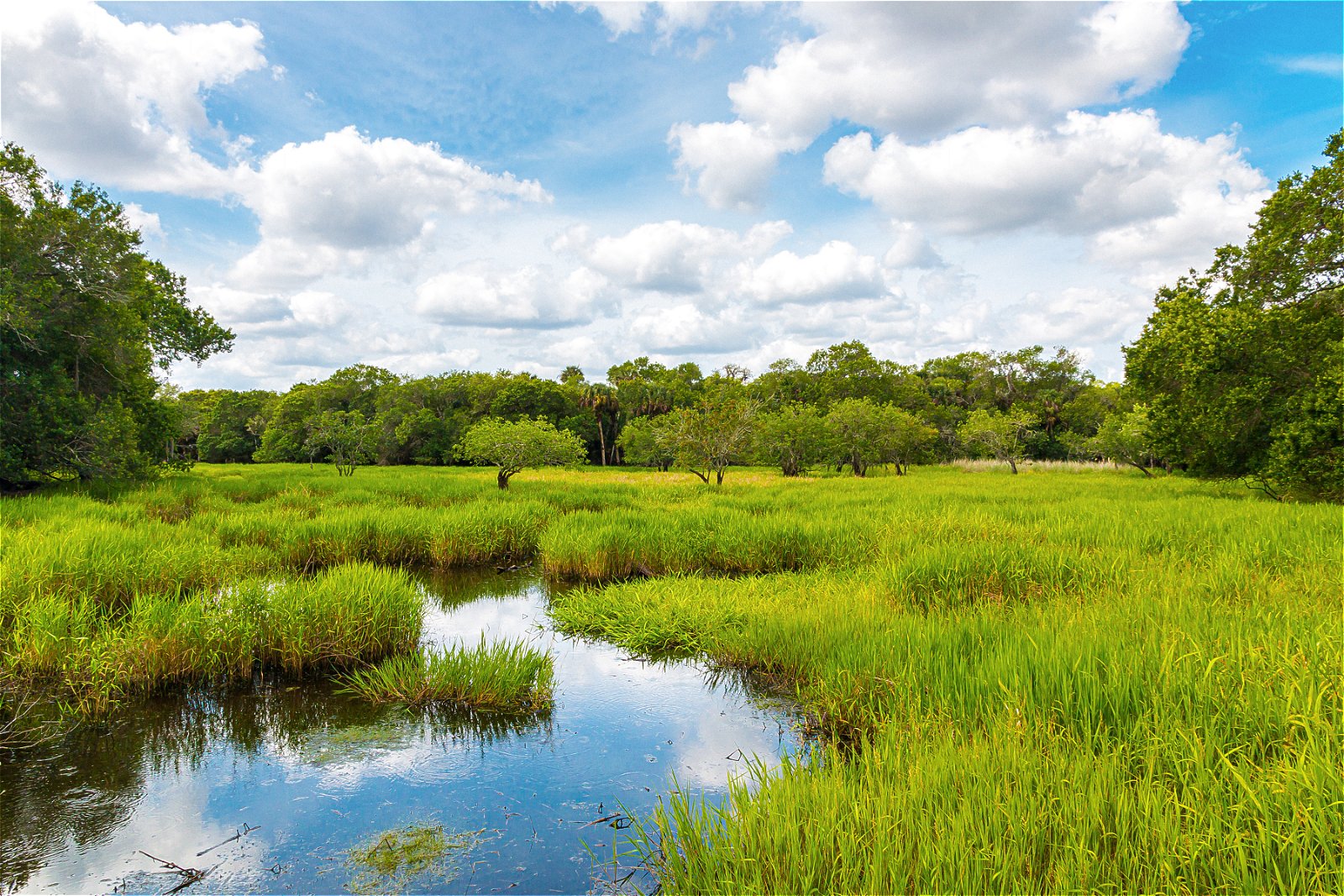
Hardwood Hammocks
Sub-Biome
In some areas of the Everglades, small islands rise 1–3 feet (.3–.9 m) above the water and are covered in trees. On these islands—known as tropical hardwood hammocks—sometimes only an acre large (4,000 m2), different trees grow, from subtropical to hardwood trees such as southern live oaks and royal palms. Though difficult for humans to navigate due to the sharp saw palmettos growing at the base of the trees, animals from mammals to reptiles and amphibians find the islands a perfect place to live.
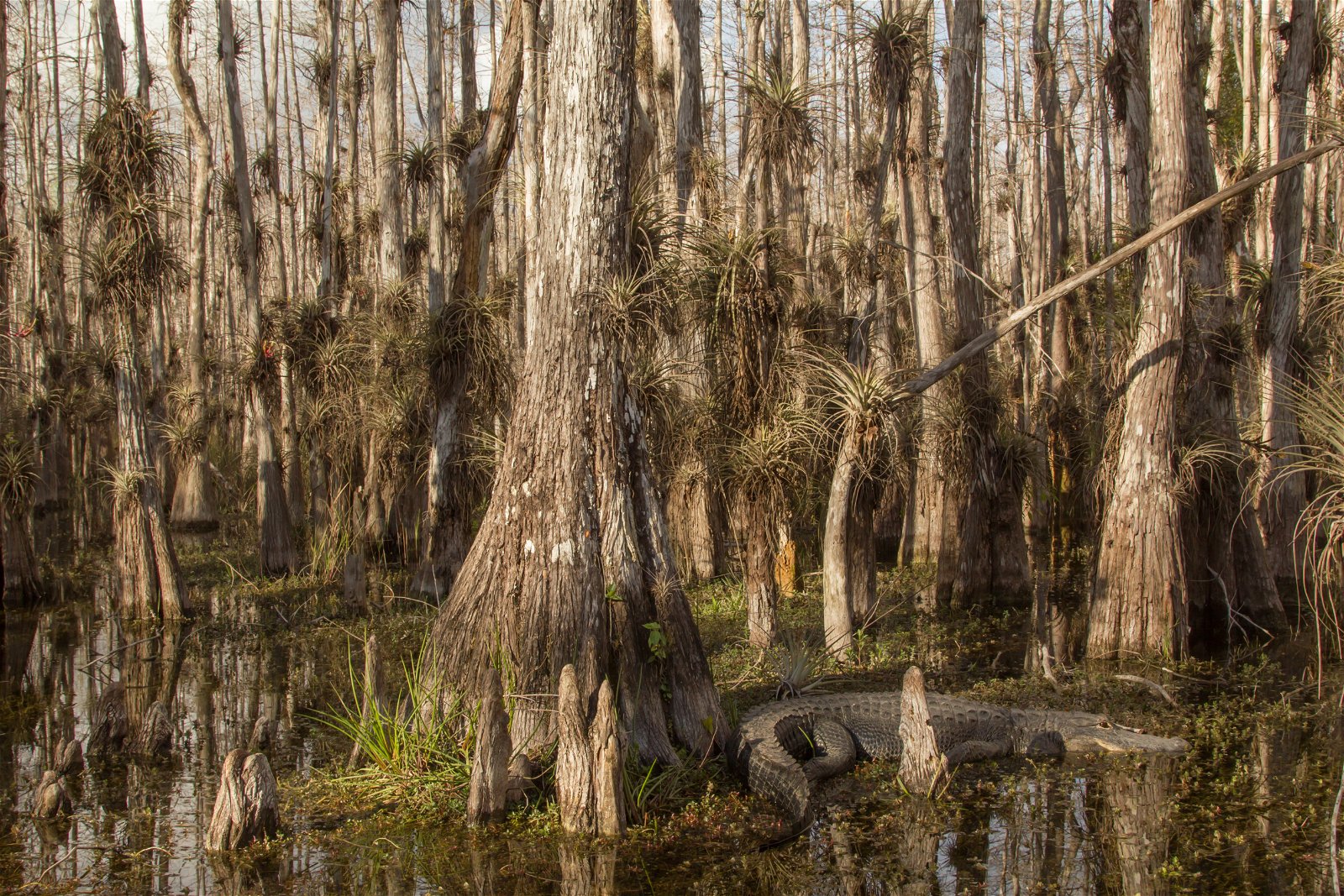
Cypress Swamps
Sub-Biome
Throughout the southern Everglades, cypress swamps adorn the landscape, from the coast to the sawgrass marshes. Cypress trees are conifers (like pines and fir trees) suited to thrive in flooded areas, especially the brackish water where fresh and salt water converge. Their roots, called knees, stick out of the water. Scientists believe these knees help provide oxygen to the root tissue, sort of like a snorkel, and might add structural support so the trees stay anchored in the soggy soil. For further security, cypresses have buttressed trunks with wide roots on every side.
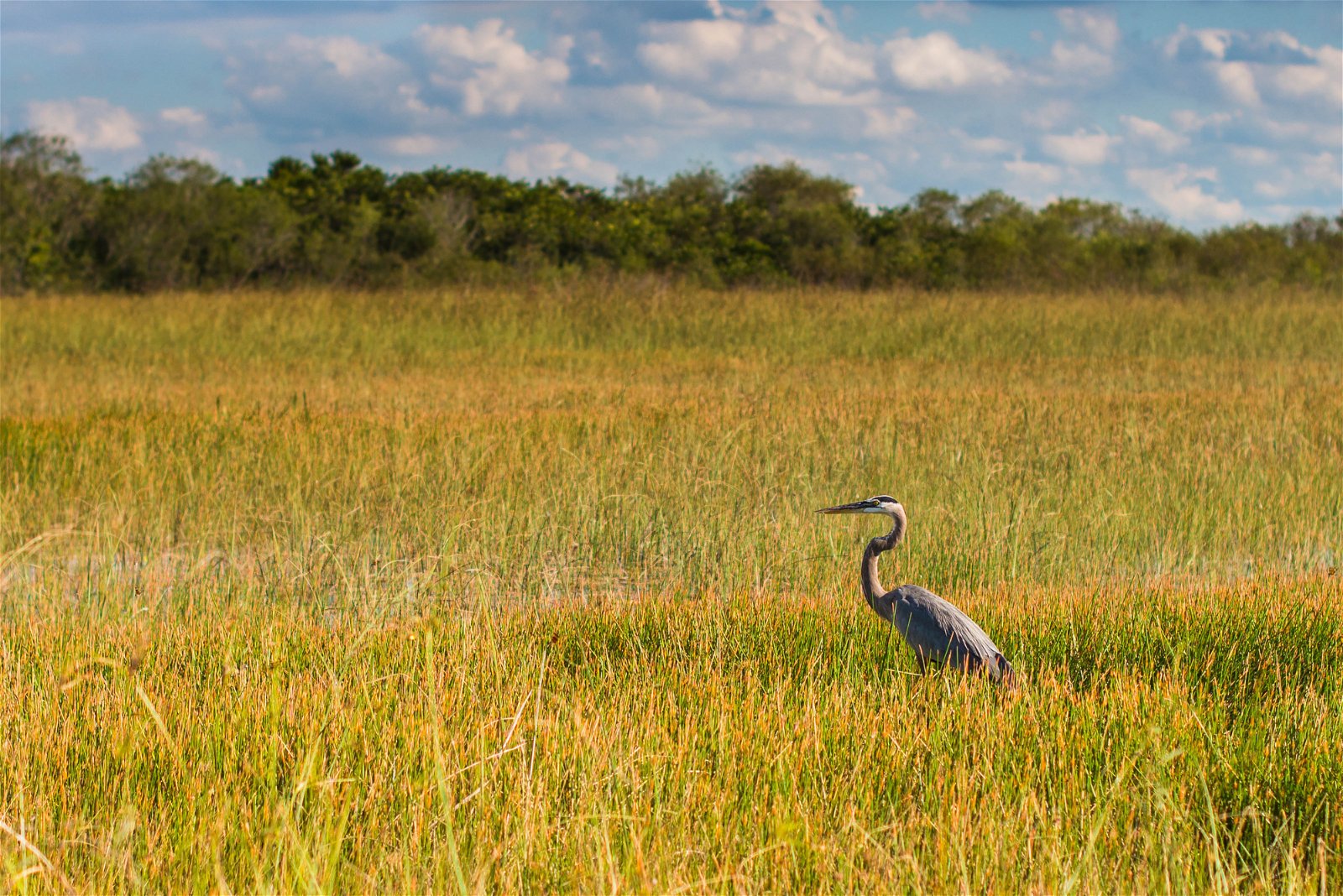
Wet Prairies
Sub-Biome
Like sawgrass marshes, wet prairies are slightly elevated with only about four inches of water flowing over them. Wet prairies host a greater diversity of plants and offer a home to snails, crayfish, and other creatures that serve as food for the wading birds that live in the area. Alligators also inhabit these prairies, digging holes for their nests. Their digging makes ponds that stay filled with water even through the dry season, providing a habitat for turtles and fish and a watering hole for small mammals that, in turn, feed the alligators.
Mangroves
Sub-Biome
The Everglades’ coast and inner estuaries are full of mangrove forests. In fact, the Everglades is home to the largest protected mangrove forest in the Western hemisphere. Mangrove trees grow well in harsh coastal conditions and tolerate tidal water where the fresh water in the Everglades mixes with salt water from Florida Bay. Some mangrove species expel extra salt through their leaves and others can filter the salt at their roots. Mangroves have stilt-like roots. In addition to being a habitat for many species of birds in their branches and fish at their roots, mangrove forests absorb the force of hurricane winds and storm surges that would erode the landscape.
Evolution and the Everglades
How did the Everglades become the landscape it is today? It depends on who you ask. An evolutionist will tell you that around 300 million years ago, North America collided with Africa to form the Appalachian Mountains. Evolutionists believe that the two continents merged as part of the supercontinent Gondwana, thus connecting what is now the foundation of Florida with North America.
Then, supposedly about 180 million years ago, continental rifting began to separate North America from Gondwana. The land that would become Florida was torn from Africa and stayed connected to North America, southeast of the Appalachians where the two continents had collided.
While part of Africa, Florida was initially above water. Now part of North America, during the supposedly cooler Jurassic Period, the land that became Florida formed a submerged platform, a shallow marine environment in which sedimentary rocks were deposited. Through the subsequent Cretaceous Period, most of Florida remained a tropical sea floor of varying depths on which lime accumulated.
As land began to submerge, the fluctuating sea levels compressed the layers of lime, sand, and fossil shells. The resulting porous limestone formations that developed between 70 and 25 supposed million years ago created the Floridan Aquifer, which serves as the main source of fresh water for the northern portion of Florida. However, under the Everglades, this aquifer lies beneath thousands of feet of flat, non-porous sedimentary rock layers from Lake Okeechobee to the southern tip of the peninsula. Because these rock layers are impermeable, the surface water cannot soak through, but instead flows across the surface, creating the watery Everglades.
But how much of that origin story is true?
The Everglades According to Genesis
Florida’s foundational rocks clearly date back to the early yearlong global flood cataclysm period only about 4,350 years ago. The fountains of the great deep had broken up (Genesis 7:11) to rip apart the earth’s outer crust into huge plates that rapidly moved across the globe. The resulting earthquakes generated enormous tsunamis that pulverized the continental basement rocks, wiping away the pre-flood world and dumping the sediments back onto that flat eroded surface.
Two of those plates carried Africa and North America. Before the mid-point of the flood, Africa slammed into eastern North America, buckling and uplifting the early flood sediment layers on the North American plate to form the Appalachian Mountains. But the internal upheaval within the earth continued so that the African plate was then ripped away from the new eastern edge of North America. Far from a clean break, the western edge of Africa remained, merging with eastern North America.
That remnant of Africa became the platform on which Florida was built.
That remnant of Africa became the platform on which Florida was built. In the latter stages of the flood, limestone layers accumulated across that platform as the flood waters washed over it. Then the flood waters retreated, partially exposing the land of Florida. In the immediate post-flood period, Florida was still mostly covered by reefs that created the limestone layer that lies directly below the surface today. This would have been especially true during high sea levels prior to the post-flood ice age.
Having been heated by super volcanoes, the very warm post-flood ocean waters spawned massive super hurricanes that, in the higher latitudes, dumped feet of snow on the colder interiors of the North American continent. Residual volcanic dust in the atmosphere meant summers were cool, so the snow accumulated continually and within decades the snow layers compressed to form the vast ice sheets and glaciers of the post-flood ice age.
Once this ice age ended after several centuries, the climate warmed and became tropical. With the warm, wet conditions and an impermeable bedrock beneath the land surface, water accumulated and flowed across southern Florida, establishing the Everglades.
Changing . . . Again
The Florida Everglades have become home to invasive species of all kinds, from the Argentine tegu to the Asian clam. But perhaps the most destructive of these invaders is the Burmese python.
The exotic pet trade brought these southeastern Asian natives to Florida. But their owners often realize too late that they don’t have the space for a creature that can grow up to 200 pounds (90 kg) and 20 feet (6 m) long. Some python owners release their pets into the Everglades—and with a balmy climate like that of their eastern home, Burmese pythons thrive in their new habitat.
With the ability to lay between 50 and 100 eggs per year and consume creatures nearly 115% of their body weight, the Burmese python has no natural predators in the US and has overtaken the Everglades since the 1990s. Experts believe tens or hundreds of thousands of pythons now call southern Florida home.
Sitting at the top of the food chain, Burmese pythons have wreaked havoc on an environment that once teemed with animals like raccoons, bobcats, rabbits, and foxes. In fact, one study found that since the python’s introduction, the populations of these species has dropped as much as 99% in some areas. These insatiable invaders are changing the face of the Everglades yet again.
Ever-Changing Everglades
Today, visitors can bike around the pinelands, kayak among the mangroves, or wade into the cypress forest. A 65-foot (20 m) observation tower even gives an elevated perspective of this wholly unique landscape we embrace as part of our diverse country. When he dedicated the Everglades as a National Park in 1947, President Harry S. Truman said, “Here are no lofty peaks seeking the sky, no mighty glaciers or rushing streams wearing away the uplifted land. Here is land, tranquil in its quiet beauty.”
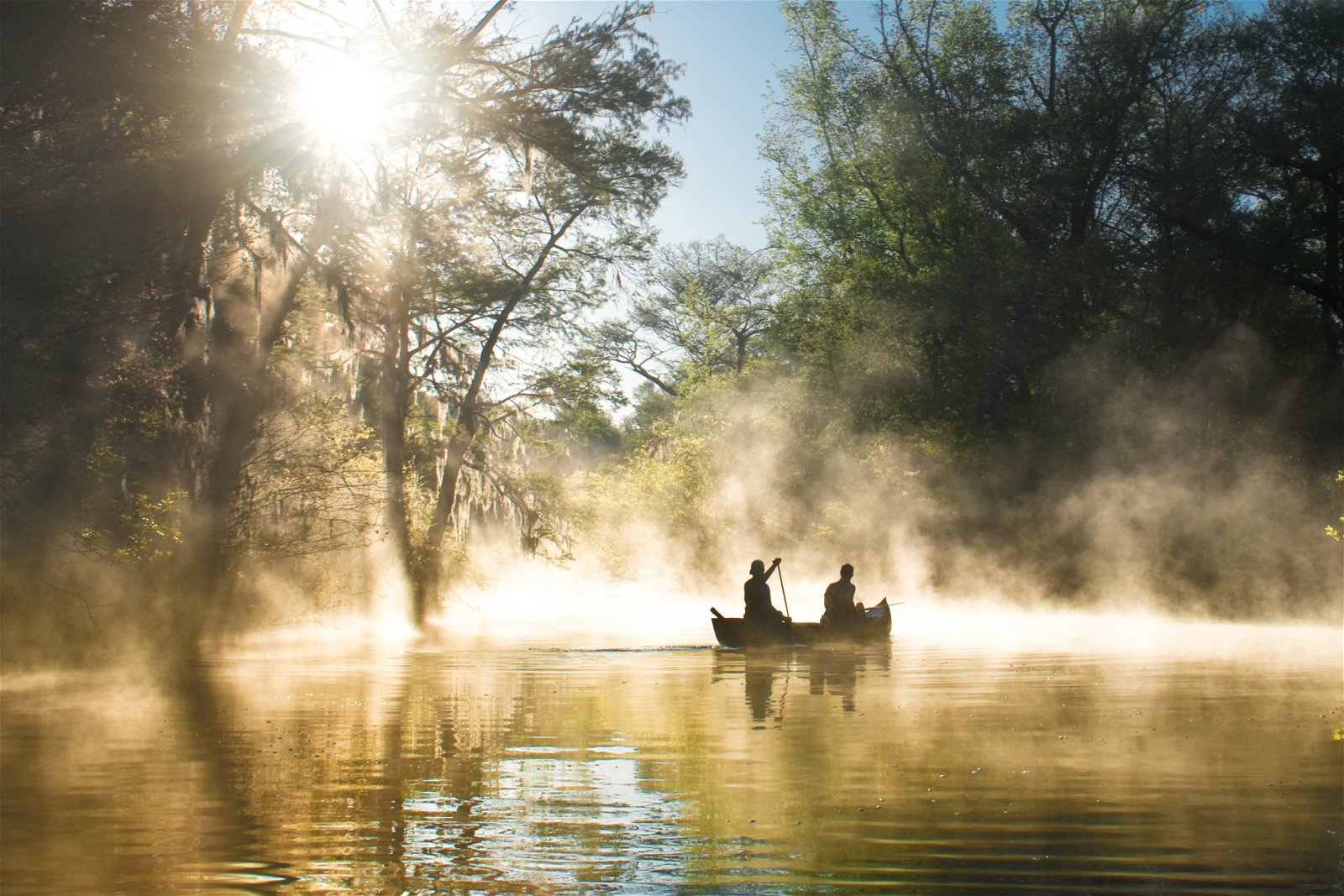
But the Everglades’ tranquil beauty doesn’t reflect the world before God’s flood of judgment reshaped the earth’s surface. Nor does it come close to the beauty of the new heavens and earth that God will refashion after his final judgment. For now, this gorgeous land of grassy water reminds us that, though no part of this earth is unchanging—not even the Everglades—the steadfast love of the Creator “is from everlasting to everlasting” (Psalm 103:17).
Former Inhabitants
When the land now forming Florida first emerged from the flood waters and stabilized, the climate was evidently quite warm and comfortable. Once the flood ended, the animals exited the ark. After a few years of reproduction and migration, some creatures eventually arrived in Florida and set up home there. The lushly vegetated land was initially home to horses, elephants, and saber-tooth cats, and then sloths, giant armadillos, and llamas. Offshore, large sharks patrolled, preying on whales—we still find their teeth and bones fossilized in lime deposits today.
But soon the climate turned cold as the ice age of a few hundred years brought on extreme global weather patterns. While the giant continental ice sheets and glaciers covered only the high latitudes of the continental land surfaces, the sea level fluctuated, falling as much as 300 feet (~90 m) and sometimes rising by as much as 100 feet (~30 m) higher than today. The falling sea level made land bridges for animals to cross as they migrated across the globe.
Animal populations changed. Now mammoths, mastodons, giant lions, dire wolves, saber-toothed cats, giant sloths, and giant beavers roamed Florida. Their large size made them suited to survive the changed climatic conditions, displacing the animals that couldn’t.
When the ice age ended and the climate warmed again, those giant mammals died out, while others thrived, living in what progressively became the ecosystems of today’s Everglades.
Today’s Inhabitants
A delightful range of creatures call the Everglades home today, including some common animals like black bears, raccoons, and white-tailed deer. Some residents are a bit more exotic. Of those residents, more than 360 species are birds. Bright pink roseate spoonbills strain shrimp from the waters. Anhingas, also called snakebirds, swim through the water with only their heads and necks above the surface. The snail kite, a raptor, feeds almost entirely on the apple snail, which grows to the size of a tennis ball.
Almost 100 species of butterflies flitter through the Everglades. Softshell turtles rest on logs, and little grass frogs, less than half an inch long (1.2 cm), hide in the wet grass. Alligators slide quietly into the brackish water. Unsightly toadfish skim the bottom of the waters, making eerie toad-like croaks.
Originally, the Everglades spanned more than 4,000 square miles (10,000 sq. km). Today, only half of that space remains undeveloped and preserved. With the loss of ecosystems, many creatures lost their habitats. Nearly 40 species in the Everglades are listed as threatened or endangered, such as the West Indian manatee and the American crocodile. The most critically endangered species, however, is the panther. Scientists estimate only 100–130 remain in the wild.
Answers Magazine
January–March 2023
Recommended Resources

Answers in Genesis is an apologetics ministry, dedicated to helping Christians defend their faith and proclaim the good news of Jesus Christ.
- Customer Service 800.778.3390
- © 2024 Answers in Genesis





